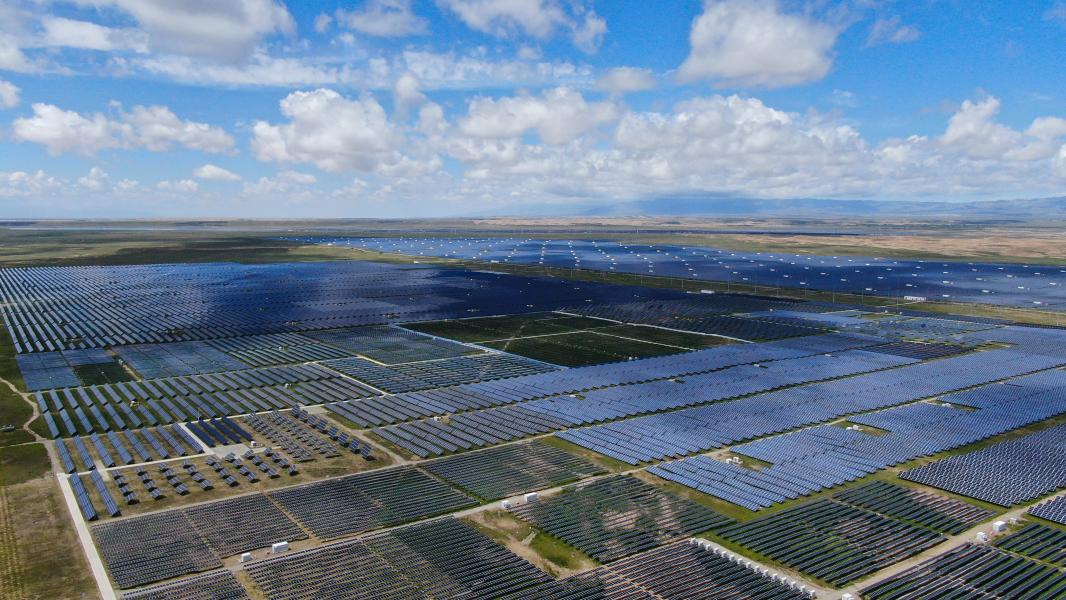New energy provides lifeline


On a plateau in Hainan Tibetan autonomous prefecture, Qinghai province, panels in a centralized solar power plant spread like a blue ocean, bringing energy to the once barren land.
On the upper reaches of the Yellow River in the province, the Longyangxia hydropower station generates electricity for both East and West China.
Rich in resources conducive to the generation of clean energy, the province has used its advantages and made the most of the opportunities offered.
Data from the provincial energy bureau show that by March, Qinghai had produced 90.2 percent of its electricity via clean energy sources. Of that figure, solar power accounted for 43 percent; hydropower produced 33 percent; and wind power accounted for 23 percent.
By March, the proportion of nonfossil fuel consumption in Qinghai's energy mix was 43.6 percent, the highest among China's provincial-level regions and far higher than the national average, the bureau said.
In 2018, the National Energy Administration gave Qinghai permission to become a national clean energy demonstration province. Under the plan, the administration supports major renewable energy projects, the introduction of industrial policy and institutional reforms.
Wang Jianjun, Party chief of the province, told Qinghai Radio and Television that by 2025 the capacity for clean energy production and the proportion consumed will have improved.
By then, China's first clean energy demonstration province will have been comprehensively established, he said.
"Constructing a clean energy system is a major way for Qinghai to transform its development path. We will carry out an all-around and historic revolution in the energy field," he added.
Last May, the province started using clean energy to power all electrical facilities in several counties, local media reported.
Under the practice, 16 counties and one town in the Sanjiangyuan region, in the south of Qinghai where the Yangtze, Lancang and Yellow rivers rise, were powered by clean energy generated by wind, water and solar sources for 100 days.
The move aimed to achieve zero emissions during power generation and promote the consumption of clean energy, according to local media.
In 2019, the province established the Camel Spring scenic spot in Xunhua Salar autonomous county. It was the first such spot in Qinghai in which all the equipment was powered by electricity. Before, the county had relied on burning oil, coal and wood, which caused extensive pollution, the reports said.
According to officials from State Grid Qinghai Electricity Power Corp, the local branch of the State-owned energy provider, Qinghai has natural advantages in terms of clean energy,
"It has vast tracts of desertified land that have huge potential for the large-scale development of solar energy plants. The province also has lucid waters, such as the Yellow River, and abundant wind resources," Fang Baomin, director of the company's electricity control center in the province, told Qinghai TV in February.
Li Yanhe, another official from the center, said salt lakes in the province provide good resources for energy storage facilities.
"For example, the Qarhan Salt Lake, the largest of its kind in the country, is in our province. These kinds of lakes offer molten salt and lithium that can lay a good foundation for the development of solar energy," he told the TV station.
Qinghai has also delivered electricity to other parts of China, including the provinces of Shandong, Henan and Shaanxi, plus Shanghai, local media reported.
In December, the Qinghai-Henan high-voltage direct current power supply grid went into operation. The project spans more than 1,000 kilometers to send a steady stream of clean energy from Qinghai to Henan.
Environmental benefits
The clean energy projects not only reduce pollution but also improve the environment.
On Tara Beach, Hainan Tibetan autonomous prefecture, solar panels have brought life to the once barren pastures, local media reported.
The panels shelter the soil from strong winds and sunlight, meaning water is retained and grass gradually grows. As the grass grows higher and thicker, the solar panels are raised and sheep are allowed to graze below them to prevent excessive growth that could inhibit solar power generation.
According to a guideline on Qinghai's economic and social development for the period of the 14th Five-Year Plan (2021-25), the province will aim to build itself into a major national new energy industry base.
"The province will focus on developing the photovoltaic system, with wind power, solar thermal and other new energies. It is expected to build a clean energy demonstration base to show that these energy sources are complementary and promote the consumption of electricity within and near the province," the guideline said.
"The province will develop an energy storage industry and promote substantive progress in the development of geothermal, shale gas and other unconventional energy industries."
- Chinese sailor forced to halt Antarctic expedition after robbery
- French, Chinese artists revive industrial heritage in Hunan
- New engineering academicians vow to advance scientific innovation
- Former top railway official expelled from CPC
- Mainland says Taiwan's Lai a 'peace breaker' and 'troublemaker'
- New materials reinforce Nanjing war truth



































